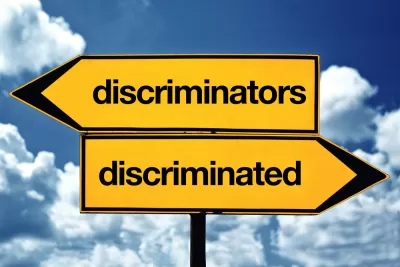Drawing on a distinction between equality and equity, Rick Jacobus argues that so-called 'poor doors' are a necessary compromise to promote affordable housing and neighborhood integration.

Having chosen to include affordable units in new project, some developers infamously provide separate entrances for the subsidized residents. "New York had been allowing this practice for years and the Times had even criticized it previously, but the phrase 'poor door’ captured the public imagination and reminded many of segregation in the Jim Crow South."
While the practice makes us squeamish, poor doors are often a misleading label. From the article: "They built a six-story [affordable] rental building immediately next to their 43-story luxury tower. What is odd about this project is not that it has two doors, but that it is considered one building at all."
More fundamentally, poor doors might be the price we pay to integrate neighborhoods. "The benefits of integration come from locating in opportunity-rich, healthier, and safer neighborhoods and not from direct social interaction with higher-income neighbors."
Jacobus points to the irony of fighting poor doors when the other option is to segregate the poor in vast under-served neighborhoods, out of sight and out of mind. "Real and meaningful economic integration will necessarily be uncomfortable. Some people will have more of everything and when we live together that difference will be awkward. To me, the 'poor door' controversy is all about avoiding that awkwardness."
FULL STORY: In Defense of the ‘Poor Door’

Alabama: Trump Terminates Settlements for Black Communities Harmed By Raw Sewage
Trump deemed the landmark civil rights agreement “illegal DEI and environmental justice policy.”

Study: Maui’s Plan to Convert Vacation Rentals to Long-Term Housing Could Cause Nearly $1 Billion Economic Loss
The plan would reduce visitor accommodation by 25% resulting in 1,900 jobs lost.

Planetizen Federal Action Tracker
A weekly monitor of how Trump’s orders and actions are impacting planners and planning in America.

Waymo Gets Permission to Map SF’s Market Street
If allowed to operate on the traffic-restricted street, Waymo’s autonomous taxis would have a leg up over ride-hailing competitors — and counter the city’s efforts to grow bike and pedestrian on the thoroughfare.

Parklet Symposium Highlights the Success of Shared Spaces
Parklets got a boost during the Covid-19 pandemic, when the concept was translated to outdoor dining programs that offered restaurants a lifeline during the shutdown.

Federal Homelessness Agency Places Entire Staff on Leave
The U.S. Interagency Council on Homelessness is the only federal agency dedicated to preventing and ending homelessness.
Urban Design for Planners 1: Software Tools
This six-course series explores essential urban design concepts using open source software and equips planners with the tools they need to participate fully in the urban design process.
Planning for Universal Design
Learn the tools for implementing Universal Design in planning regulations.
Caltrans
Smith Gee Studio
Institute for Housing and Urban Development Studies (IHS)
City of Grandview
Harvard GSD Executive Education
Toledo-Lucas County Plan Commissions
Salt Lake City
NYU Wagner Graduate School of Public Service



























